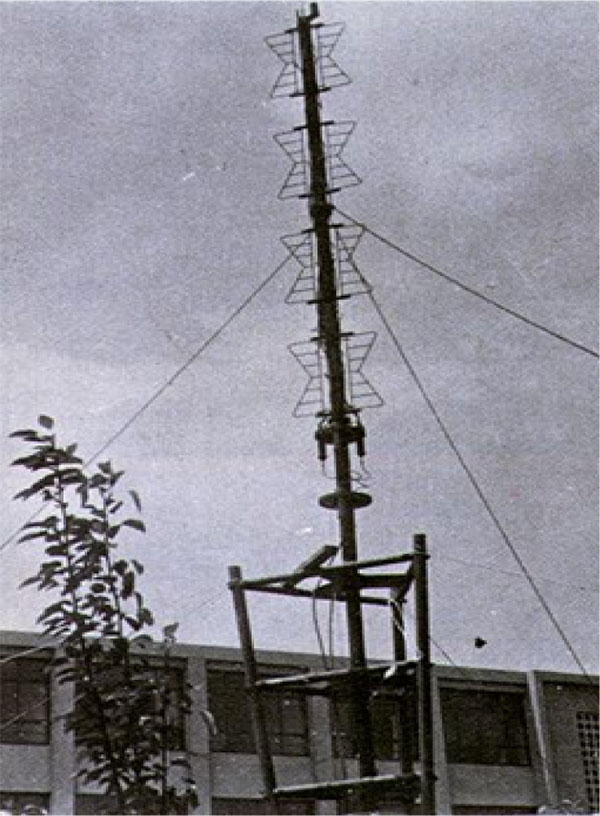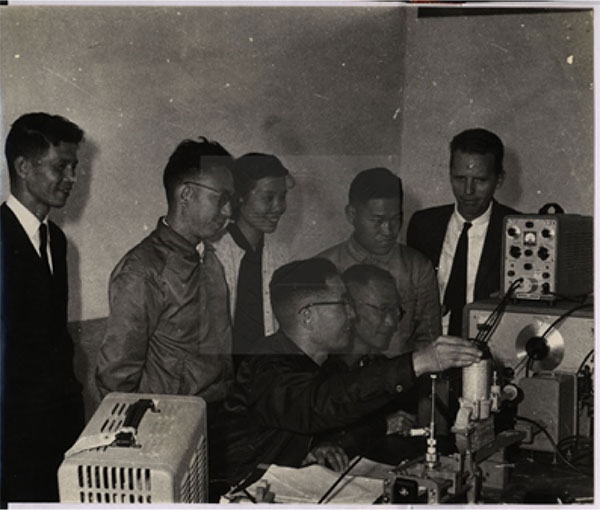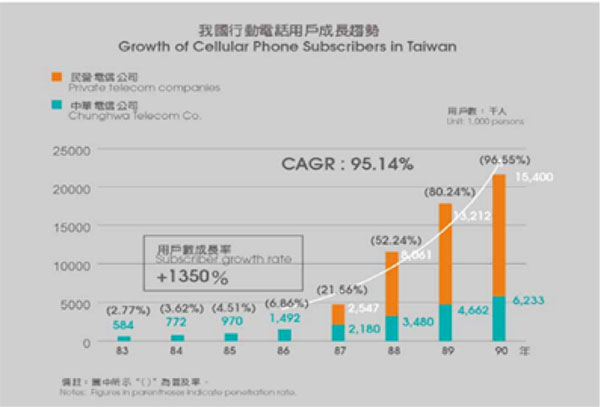1961: Origin of the Institute of Communications Engineering (ICM)
★
United Nations Training and Research Center for Telecommunication and Electronics Center was established
★
The successful trial broadcasting of the self-developed TV transmitter marked the inception of TV broadcasting in Taiwan.
The TV transmitter utilized the high-frequency output of a video recorder and was equipped with a self-developed high-frequency linear amplifier to amplify the output signal to 5 watts. The sound transmitter was self-developed with a 3-watt modulation transmitter and a four-pole Yagi–Uda directional antenna, made by Hu, Jialun (胡家倫). At that time, our university did not have a mechanical laboratory and had to rely on an outsourcing studio for production. However, due to limited ironwork skills, multiple modifications and reproductions were required to meet the specification. At the beginning, the transmitter was set up in front of the Chu-Ming Building (竹銘館), and the first trial in Hsinchu was successful. Then, the transmitter was move to the 7th floor of the National Education Data Center in Taipei and a three-day public trial was sponsored by the Chinese Institute of Engineers. During their trial, 5 televisions, borrowed from Yong-Kang Company (永康公司), were placed at the Music Station of New Park for public viewing.

The first trial of TV broadcasting in Taiwan
1966: Establishment of the Department of Communications Engineering
★
Department of Communications Engineering was established (Chair: Zhang, Dan)
★
Professor Ding-Xun Wen assumed the second department chair and established Microwave Laboratory
From 1961 to 1973, Lan Jen Chu (MIT) taught electromagnetic wave antenna design and assisted in the establishment of departments in 1964. In 1962, McNally (Bell Lab), an expert in vacuum tubes, came to the university to give lectures and set up laboratories; In 1963, G. C. Dalman and I, serving as a lecturer, established a vacuum system (including ion, diffusion, mechanical pumps and vacuum chambers). Later, in 1964, I used these "scrap" old pumps to successfully build an Al-Evaporator system which can achieve 10-6 Torr! In 1964, Prof. Ding-Xun Wen, Prof. Chao-Chen Wang, Shing-Chung Wang, and Ding-Hua Hu (Prof. Wang’s master student) established the first laser (Ruby Laser and He-Ne Laser) and the Microwave Laboratory in Taiwan.

Prof. Dalman and the microwave communication laboratory
1979: Establishment of the Institute of Communications Engineering
★
Institute of Communications Engineering was established (Director: Chi-Fu Den)
Dr. Chi-Fu Den (Former NCTU President)
Presidency:1992~1998
Core Ideas:
Claiming humanity as the basis of academic development, promoting the respect for teachers, and regarding success of education and recruiting of scholars as the conditions for the university to be at the top rank.
Presidency:1992~1998
Core Ideas:
Claiming humanity as the basis of academic development, promoting the respect for teachers, and regarding success of education and recruiting of scholars as the conditions for the university to be at the top rank.

The official document of the establishment of the Institute of Communications Engineering
1989-1995: Development Period of Institute of Communications Engineering
★
In 1989, the Center for Telecommunications Research (CTR) was established.
★
In 1990, the Department of Communications Engineering doubled its scale and successfully developed the first millimeter-wave planar oscillator in Taiwan.
★
In 1992, the doctoral program of the ICM was established
★
In 1993, the International Conference on Telecommunications hosted by the Institute of Communications Engineering, invited more than 320 participants and published 127 papers.
★
In 1994, the College of Electrical and Computer Engineering was established, which was the first College of ECE in Taiwan.
1996-2000: Rapid Development of Data Communications and Mobile Networks
★
Telecommunication liberalization in Taiwan
★
Windows 95 achieves commercial success leading to the era of personal computers
★
Wi-Fi (IEEE 802.11b) provides wireless connectivity in the home, office, and some commercial establishments.
★
The popularization of 2G mobile data networks has opened up cell phone applications and connected to a huge amount of Internet resources.
Telecommunications in Taiwan
After the passage of the Telecommunications Three Acts in 1996, the regulatory oversight and operation of the telecommunications industry, handled by the Directorate General of Telecommunications, were separated. True telecommunication liberalization had finally come after this separation, with the Directorate General of Telecommunications taking the initial step in 1997 by opening up four mobile communication services, including mobile phones, radio paging, mobile data, and trunked radio. The opening up continued with the introduction of satellite communication services in 1988 and the 1900MHz mobile phone service in 1989.
These services primarily involved the opening up of wireless spectrum resources and had relatively lower difficulty in infrastructure construction. Consequently, the mobile phone business indeed flourished, and by 2002, the mobile phone penetration rate reached 108%, making it the highest in the world at that time. However, the greatest challenge to telecommunication liberalization came later in 2000 with the opening up of fixed communication services and the establishment of related fair competition.
After the passage of the Telecommunications Three Acts in 1996, the regulatory oversight and operation of the telecommunications industry, handled by the Directorate General of Telecommunications, were separated. True telecommunication liberalization had finally come after this separation, with the Directorate General of Telecommunications taking the initial step in 1997 by opening up four mobile communication services, including mobile phones, radio paging, mobile data, and trunked radio. The opening up continued with the introduction of satellite communication services in 1988 and the 1900MHz mobile phone service in 1989.
These services primarily involved the opening up of wireless spectrum resources and had relatively lower difficulty in infrastructure construction. Consequently, the mobile phone business indeed flourished, and by 2002, the mobile phone penetration rate reached 108%, making it the highest in the world at that time. However, the greatest challenge to telecommunication liberalization came later in 2000 with the opening up of fixed communication services and the establishment of related fair competition.

Telecommunication liberalization in Taiwan
2001-Now: ACT TOGETHER, WE GO FAR
★
In 2009, the Department of Electrical and Control Engineering and the Department of Communications Engineering were merged into the Department of Electrical and Computer Engineering.
★
In 2021, the Department of ECE was renamed the Department of Electronics and Electrical Engineering, merging with the Department of Electronics and the EECS Undergraduate Honors Program.
★
The Department of Electronics and Electrical Engineering has been the biggest EE department in Taiwan, with the largest number of teachers and students.



